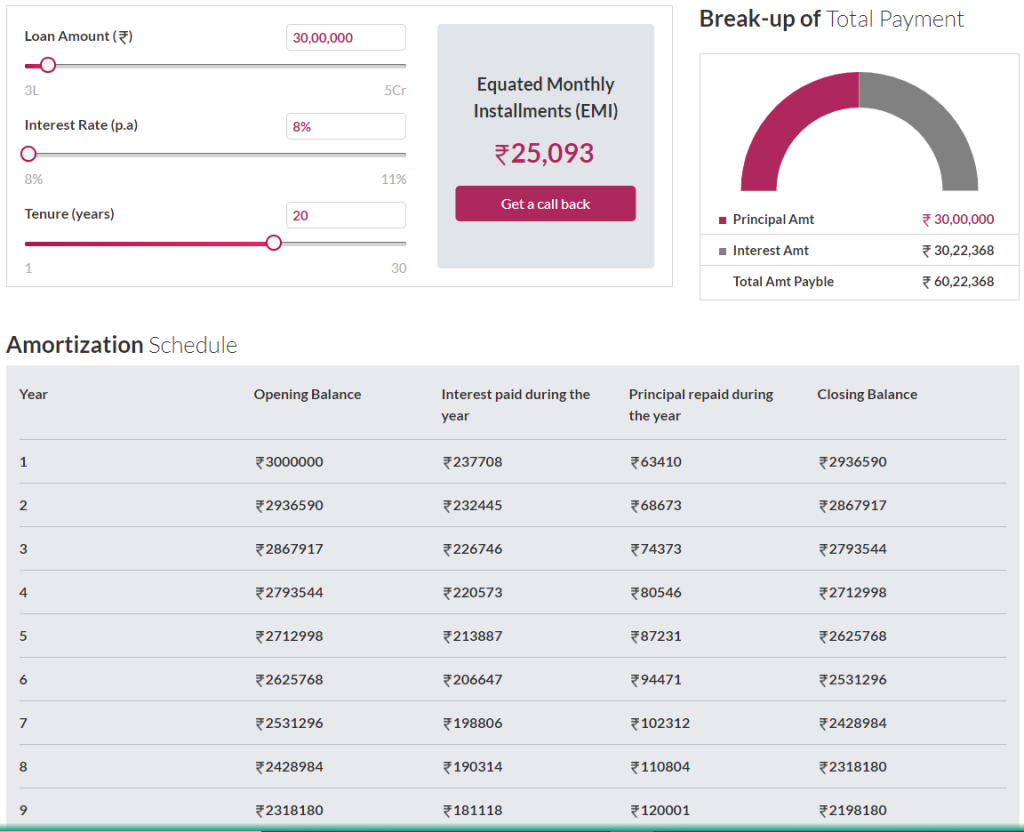Home loan is a type of loan which a working taxpaying citizen takes in its life time at least once. Deduction using home loan Section 24 provides us biggest opportunity on saving tax but it’s least understood especially by new applicants. Those who have taken loan earlier must have gone through many articles on tax deduction but they never gave a complete view of this section. In here today we will try to give you complete information using simplest manner, let’s begin:
To begin with home loan repayment is done through Equated Monthly Instalments (EMI), which is divided into two parts first Principle & other is interest. Irrespective of organization from which loan has take, in repayment EMI’s initially interest portion is less & principle portion in more; towards the end interest portion is more & principle portion in less. (see image below)

As per our first blog deduction on Section 80C principle portion is covered under it, person can claim deduction upto Rs. 1.5 Lac yearly. But that’s not all we can claim deduction on interest portions also & that can be claim under Section 24, its particulars are:
- Maximum deductable amount Rs. 2 lac (for self owned property).
- For let out property, there is no upper limit for claiming interest.
- To claim deduction house property should not be sold within 5 years of possession. Otherwise, the deduction claimed earlier will be added back to your income in the year of sale.
Notable Points
- You may claim deduction on both HRA (Sec 80GG) & home loan (principle & interest) in same financial year.
- Deduction under Section 24 is over & above Rs. 2 Lac (i.e. 80C) deduction.
- If you’re a co-borrower and also co-owner of the house, you can each claim up to the maximum deductible amount under this section.
Government also provide other opportunities to save some additional tax form investment in home. But this additional opportunity is for those who have taken home loan in specific period, learn below:
Sub Section 80EE (80EE)
Section 80EE allows income tax benefits on the interest portion of the residential house property loan availed from any financial institution. You can claim a deduction of up to Rs. 50,000 per financial year as per this section. You can continue to claim this deduction until you have fully repaid the loan.
Eligibility criteria:
- The loan must have been sanctioned between 1st April 2016 to 31st March 2017.
- The deduction under this section is available only to individuals
- Value of the house should be Rs 50 lakhs or less
- Loan taken for the house must be Rs 35 lakhs or less
- The loan must be sanctioned by a Financial Institution or a Housing Finance Company.
Sub Section 80EE (80EEA)
To extend the benefits of 80EE a new section has been introduced by govt this year called section 80EEA, it is to promote housing in India. You can say it’s the extended version of 80EE, under this section (80EEA) person can claim deduction upto Rs. 1,50,000. But one thing need to be remembered that both are mutually exclusive if you are taknif benefit under section 80EE you could not claim deduction under section 80EEA.
Eligibility criteria:
- The loan must have been sanctioned between 1 April 2019 to 31 March 2020.
- The deduction under this section is available only to individuals
- Individual should not be claiming deduction under section 80EE
- Value of the house should be Rs 45 lakhs or less
- The taxpayer should be a first-time home buyer. The taxpayer should not own any residential house property as on the date of sanction of the loan.
- The loan must be sanctioned by a Financial Institution or a Housing Finance Company
- Carpet area of the house property should not exceed 60 square meter ( 645 sq ft) in metropolitan cities.
- Carpet area should not exceed 90 square meter (968 sq ft) in any other cities or towns.
- To claim deduction you should not own any other house property on the date of the sanction of a loan.
With this we end our Section 80 series, there are still more section left in it but they are not that commonly used we will discuss them later on under our Advance series of Basics Of Income Tax. In our next blog on Basics Of Income Tax we will sum up all our learning we have gathered till now & will show you by example that how much tax can be saved using these common sections, see you soon.
 Vriddhi India Empowering You
Vriddhi India Empowering You




